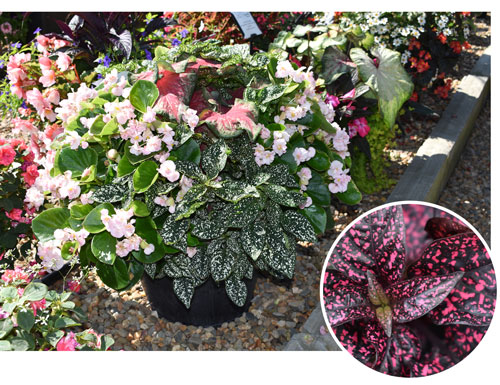10/1/2023
Lotty Dotty Hypoestes: A Great Choice for Shady Spots
Bart Hayes

The new vegetative Lotty Dotty series of hypoestes continues the FanciFillers concept, but in a more shade-tolerant plant series. Dark green leaves are spattered with an abundance of colored spots—to the point of the leaves being mostly spots. This bright splash of color is perfect for shade-loving combinations, but also thrives in the darker corners of the landscape, giving a new option for home gardeners everywhere.
To be clear, this isn’t your Grandma’s polka dot plant (although she’ll love it). The Lotty Dotty series has about twice the vigor, easily filling out larger containers or in-ground plantings, reaching 12 to 18 inches in height. This robust, well branched series will compete with part-shade and full-shade annuals that would normally overwhelm less-vigorous companions.
Pictured: Begonias, impatiens and other shade-loving plants are ideal combination planting partners for Lotty Dotty Hypoestes. This photo was taken at Young’s Plant Farm Trial Gardens Open House on June 6, 2023. ■ Inset: Closeup of Lotty Dotty Rose Hypoestes.
Production is pretty straightforward and fast. Rooting should take four weeks, but finishing should take eight weeks or less, especially under warmer conditions. This is another big difference between the Lotty Dotty series and the traditional seed-produced products.
Propagation
I recommend sticking cuttings into a 105-count tray filled with well-draining, loose-filled propagation media or engineered soil plug. I personally prefer an engineered soil product because I think it avoids inconsistent liner rooting due to soil compaction or particle separation. Also, KIBA at 100 ppm is recommended to enhance rooting speed and uniformity. Not an absolute necessity, but it seems to help.
For best results, keep at a steady temperature of 68 to 76F (20 to 24C), and mist only enough to keep the soil moist and humidity high until root initials are visible; approximately seven to 10 days. Reduce humidity gradually and begin to feed at 100 to 150 ppm N once vegetative growth begins again.
A pinch is recommended once plants have rooted to the side of the propagation cell (22 to 26 days) and have begun to produce new growth to enhance branching and to help control growth.
Growing on
Once very well rooted, plants can be transplanted into a well-balanced, well-drained soilless media with a soil temperature of 68 to 72F (20 to 22C) throughout the rooting period. Maintaining warmer temperatures will be key to rapid development, leaf expansion and growth.
After initial establishment, continue to water early in the day to allow foliage to dry and soil to dry slightly in between watering.
Light
Supplemental lighting will aid in enhancing leaf color and will also improve overall plant performance.
Growth regulation
Chemical growth regulation shouldn’t be necessary, but B-Nine at 500 ppm can be used. Height control can be achieved with good water management.
Fertility
Fertilize at medium rates (200 ppm N of 20-10-20, for example) to allow for healthy growth. An EC between 1.2 and 1.5 (using 1:2 extraction method) and pH between 5.2 and 5.6 is recommended. Be sure to regularly check soil pH and EC as part of a comprehensive plant health management program. Flush with clear water to avoid excessive salt buildup.
Additional notes
Avoid excessive drying and cold temperatures, as it can lead to leaf drop. Transition from shade to high light can result in leaf edge curling, so be sure to transition gradually or avoid high light conditions.
Estimated finish times
102 cell Grow time Plants per pot
4.5-in. pots 8 weeks 1 ppp
6.5-in. pots 8 to 10 weeks 2 to 3 ppp
And, as always, one of the big advantages that Westhoff is able to offer is that Lotty Dotty is available as an unrooted cutting from several of our offshore cutting farm partners, as well as dozens of root-and-sell operations all across North America. This diversity of supply chain helps growers find the best solution for their production needs while ensuring a robust and consistent supply. To help decide how to receive these new varieties, reach out to your preferred broker sales representative for more detailed information or contact me directly with additional questions. GT
Bart Hayes is the Sales Manager for Westhoff. He can be reached at bart.hayes@westflowers.de.